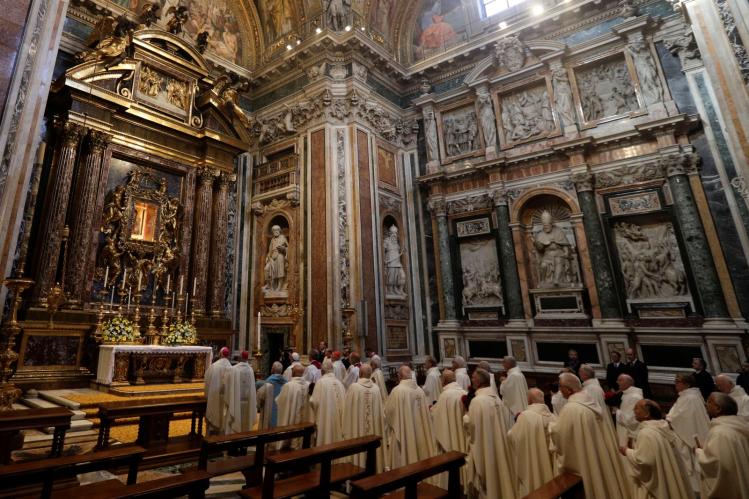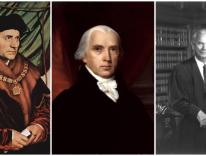
In their fascinating exchange on the clergy (“Imagine There’s No Clergy”), William M. Shea and David Cloutier seem unable to distinguish the “clerical state” from the “sacrament of orders.” One author appears to seek elimination of both for the sake of evangelical renewal, while the other appears to seek preservation of both for the same reason.
Contrary to what appears to be the argument of both authors, the “sacrament of orders” and the “clerical state” are historically distinct and institutionally separable. During its first three centuries, the Greek-speaking church developed and sustained the “sacrament of orders” for episcopoi, presbyteroi, and diaconoi (bishops, presbyters, and deacons). But there was as yet no “clerical state.” That came only in the fourth century, through the Constantinian fusion of the Catholic Church with the Roman Imperial State.
In that fusion, the leadership of the Roman Empire transferred imperial “hierarchical” privileges from the pagan priesthood to the ordained servant-leaders of the Catholic Church. The new imperial “clergy” were legally empowered to rule over the non-clerical “laity.” Prior to this development, the entire church (meaning both ordained servant-leaders and the entire membership) had been understood as both sacredly lay (the holy laos) and as divinely chosen (the holy kleros).
Since the sacrament of orders and the clerical state are historically distinct, the former having existed for three centuries without the latter, that means they are also institutionally separable. Indeed, in the Western Church canon law recognizes the distinction between the sacrament of orders and the clerical state. When Roman Catholic priests decide to marry, they may apply for a “reduction” to the lay state. This reduction removes them from the clerical state but, according to official church teaching, they remain ordained priests “ontologically.”
In short, the sacrament of orders is of apostolic origin, while the “clerical state” is a fourth-century legal construction by the Roman Empire. Later, in the eleventh century, the Western Catholic clergy were further segregated from the laity when the papacy imposed mandatory celibacy on all diocesan presbyters and bishops in the West. (By so doing, the papacy also forced many wives of bishops and presbyters into homelessness, slavery, or even suicide. See Anne Llewellyn Barstow’s book Married Priests and the Reforming Papacy.)
Then, in the sixteenth century, the Council of Trent segregated the clergy still more by mandating formation in monastery-like clerical seminaries. These structures uprooted candidates for ordination from their original lay communities of kinship and friendship, prepared them to become part of a “chosen” clerical caste, and molded them for work as interchangeable parts within a standardized and often-impersonal ecclesiastical bureaucracy.
Today, across the Americas and elsewhere, Western Catholics are flooding out of often stagnant Catholic parishes into more dynamic Evangelical and Pentecostal congregations, whose pastors long ago returned to the original apostolic model of non-clerical and lay servant-leadership. In general, these lay pastors relate much more effectively to the lay experiences and spiritual needs of the wider laos that they serve.
Of course, from a Catholic perspective, these churches also suffer from serious theological problems, including biblical literalism and the so-called “Gospel of Prosperity.” And all too often these churches support patriarchy and authoritarian governments. But the Catholic Church can still learn from their non-clerical model of pastoral ministry, with its clear roots in the presbyterate of the early church.
The clerical enculturations of the Roman Catholic presbyterate, which have developed in stages since the fourth century, now need to be dismantled for the sake of twenty-first-century global evangelization. The sacrament of orders needs to be rescued from the legal overlay of clericalism that today blocks its spiritual power and fosters a bureaucratized caste system. At the same time, the entire Catholic laos needs to recover its apostolic mission and sacred identity, which clericalism has frequently obscured. Declericalizing the Western Church would not secularize it—or desacramentalize it, as David Cloutier fears. On the contrary, it would return the church to its roots and remind it that the entire laos is sacred and chosen.
Pope Francis has rightly challenged “clericalism” across the Western Church, but he seems to regard it only as a problem of attitude. Rather, it is a structural problem with deep historical roots, and one that reproduces itself from one generation to the next. If we are serious about moving beyond clericalism, and not just lamenting it, we can begin by distinguishing between the sacrament of orders, which we still need, and the clerical state, which we would be better off without.
Please email comments to [email protected] and join the conversation on our Facebook page.
Previous Story
A Hard-Earned Detachment
Next Story
Pope Francis’s ‘Gaudete et Exsultate’


